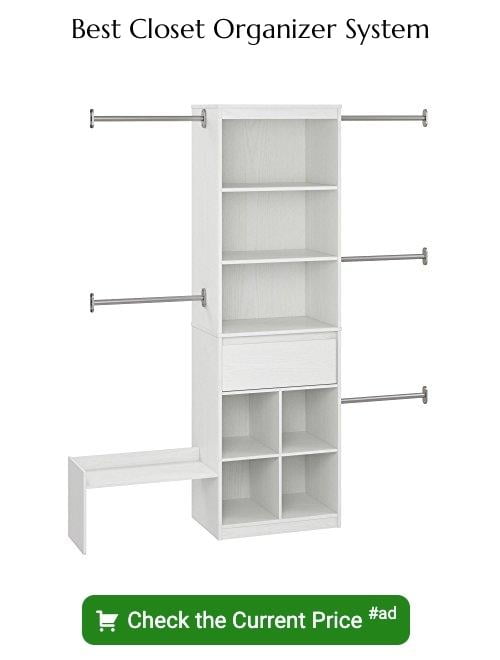Last updated on
Organizing a closet becomes a breeze once you understand the importance of closet depth for hangers, because it directly affects how well clothes can be stored and accessed.
Key takeaways:
- Reach-in closets should have a depth of at least 24 inches.
- Walk-in closets should ideally have a depth of 36 inches.
- Consider clothing size, door swing, and closet rod placement when determining closet depth.
- Hanger dimensions and closet depth should be compatible to prevent damage to clothes.
- Shelving depth and hanging space depth should be differentiated for optimal storage.
Reach-in Closet Standard Depth
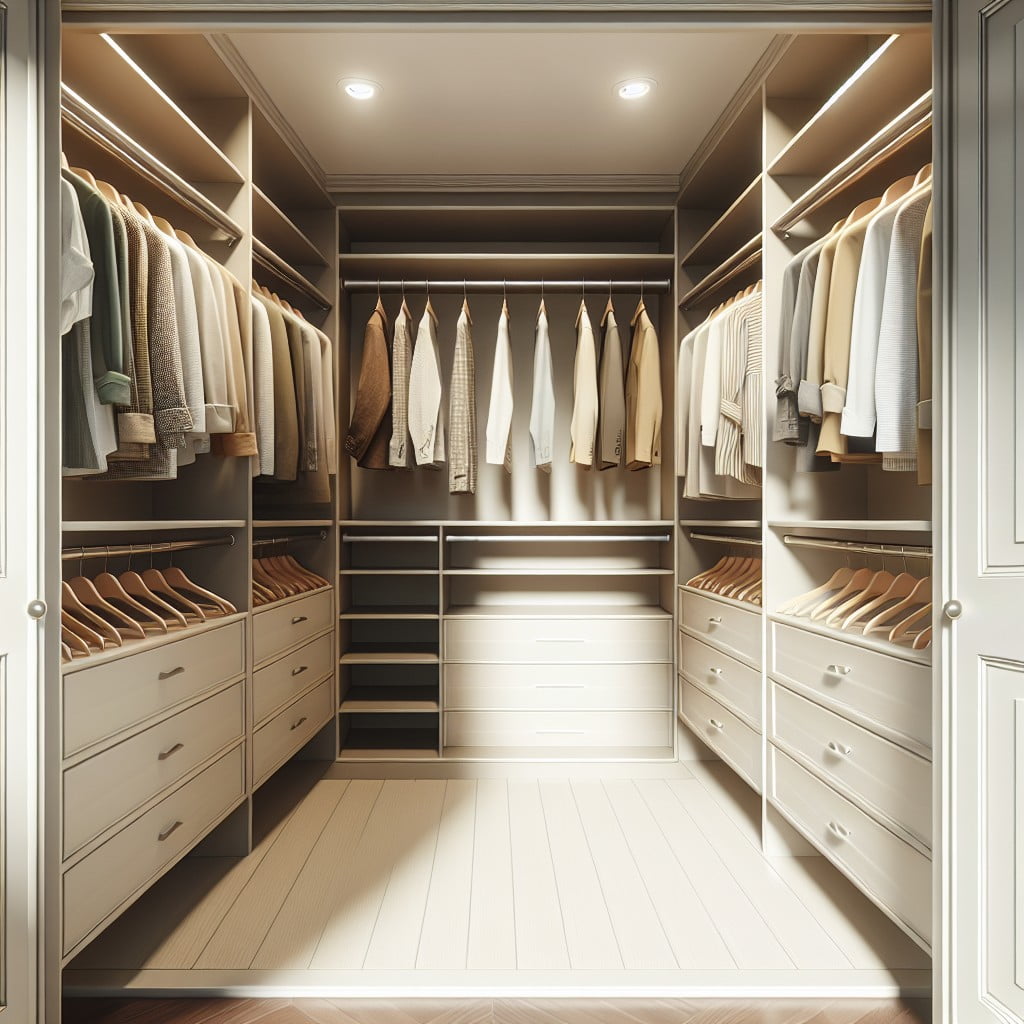
For optimal functionality, a reach-in closet’s depth should typically measure at least 24 inches. This dimension allows for standard hangers and clothing to hang perpendicular to the back wall without brushing against it.
When planning, consider the following:
- Clothing Size: Ensure there is ample room to accommodate larger items like coats or dresses without them being cramped or wrinkled.
- Door Swing: If using hinged doors, the depth must account for the door’s sweep to avoid interference with clothes.
- Closet Rod Placement: Install the closet rod at least 12 inches from the back wall so hangers can freely slide.
- Depth Extensions: For closets deeper than 24 inches, consider adding storage solutions like bins or shelves to utilize the extra space.
Choosing the right closet depth tailored to these considerations ensures clothes are kept neatly and accessible, providing both aesthetic and practical benefits to your wardrobe management.
Walk-in Closet Depth Requirements
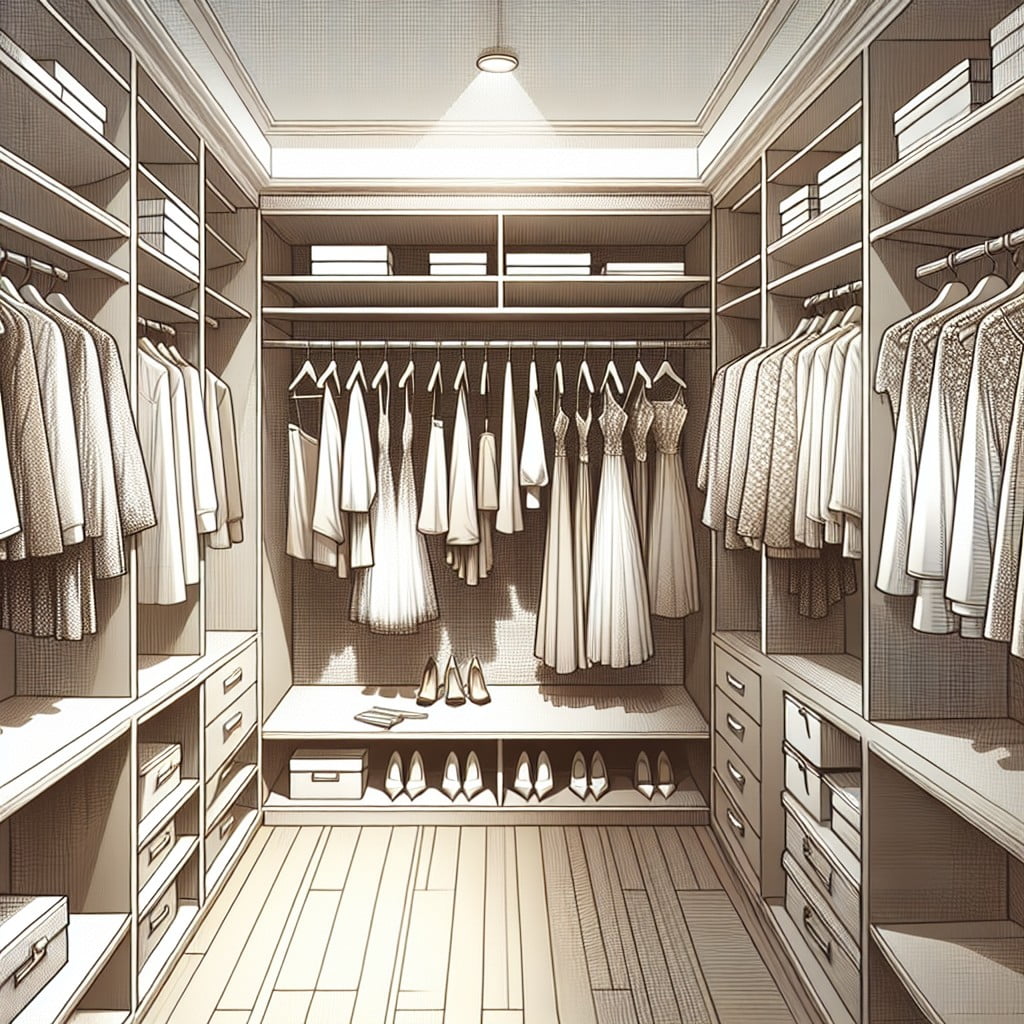
When considering walk-in closets, the space necessary to store clothing and other items conveniently can vary. Ideally, the depth starts at 24 inches, providing ample room for most garments on hangers. However, to create a more luxurious and accessible space, a depth of at least 36 inches is recommended. This allows for a comfortable browsing experience and prevents clothes from becoming cramped or wrinkled.
An important aspect to keep in mind is the clearance for walking. For a single-sided walk-in closet, ensure at least 36 inches of walkway space between the hanging garments and the opposite wall or storage. For a closet with storage on both sides, aim for 48 to 72 inches of central aisle space for ease of movement.
Additionally, consider the type of items you plan to store when deciding on your closet’s depth. If you plan to include shelves or drawers, the depth can be decreased slightly, as folded items require less space than hanging ones. Always measure your longest garments, such as dresses or coats, to ensure that the closet depth will accommodate them without bunching at the bottom.
Hanger Dimensions and Closet Depth Compatibility
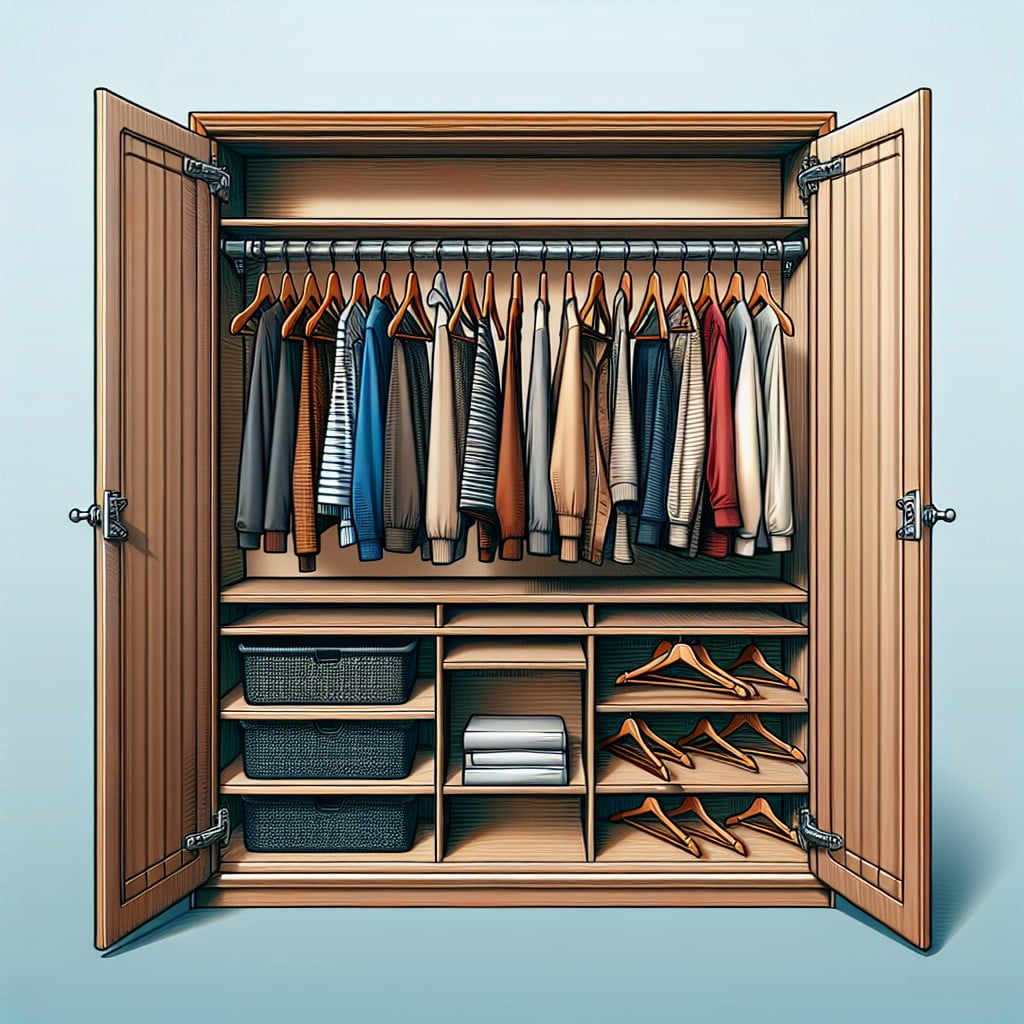
Understanding the interplay between hanger size and closet depth ensures proper garment storage without cramping or damage. Standard hangers are typically 17 to 18 inches wide, whereas slim-line hangers may be narrower. To accommodate the width and allow for a little wiggle room, a closet should have a minimum depth of 24 inches. This ensures that clothes hang freely and doors can close easily without squeezing the fabric.
Keep in mind that bulky items like winter coats require more space. For these, a depth of 28 inches can prevent crushing and maintain the shape of heavier garments. Moreover, consider the added clearance for hangers with swivel hooks, which might necessitate an additional inch or so for smooth operation.
Minimum Closet Depth for Hangers to Fit Comfortably
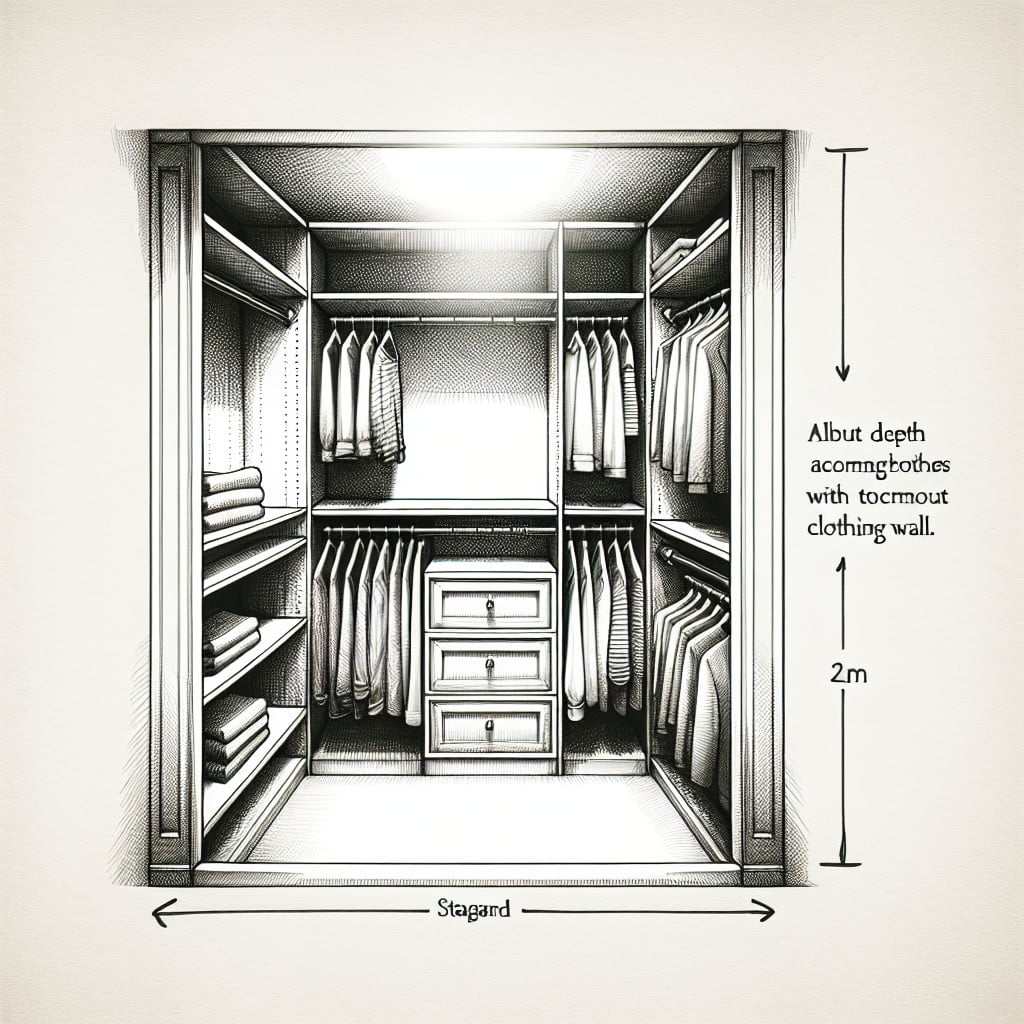
To ensure your garments hang freely without crumpling against the closet door or back wall, a minimum depth of 24 inches is standard. This space accommodates most hangers and provides ample room for clothes to maintain their shape.
Here are key points to consider:
- Wire hangers usually require less space, but for durability and clothing care, plastic or wooden hangers are preferable. These sturdier options typically measure around 17-18 inches wide.
- For coats or bulkier items, allow a few extra inches of depth to prevent crushing or deformation.
- Remember to account for the inward swing of the closet door, if applicable, and maintain a clearance of at least 2 inches from the door to the clothes.
- When measuring interior depth, start from the closet rod to the nearest obstruction, not just the back wall, to include any additional framework or built-ins.
- For non-standard hangers such as those for pants or skirts, verify their specific dimensions as they may vary from standard hanger sizes.
By adhering to these guidelines, you’ll create a functional space that keeps your clothes accessible and in prime condition.
Shelving Depth Versus Hanging Space
In designing your closet, it’s crucial to differentiate between the depth needed for shelves and hanging garments:
- Shelving for folded clothing typically requires a depth of about 12 inches, ensuring that sweaters, shirts, or pants can be neatly stacked without hanging over the edge.
- Hanging space, on the other hand, demands deeper dimensions. For most clothes hangers, a depth of at least 24 inches is necessary to prevent garments from being compressed against the closet doors or walls.
- For coats or bulkier items, consider a depth of 28 inches, allowing these larger pieces to hang freely without becoming misshapen.
- It’s possible to incorporate both shelving and hanging areas within the same closet. Strategic design — with shallower shelves above or beside deeper sections for hangers — can maximize space efficiency.
- To accommodate both elements, some opt for an adjustable closet system, which allows for customization based on current storage needs, a particularly helpful feature as wardrobe changes with the seasons.
By understanding these distinctions, you can create a closet with a balance between shelving and hanging space that caters to the entirety of your wardrobe needs.
Calculating the Ideal Closet Depth for Your Needs
To determine the perfect closet depth for your clothing and storage needs, consider these factors:
1. Clothing Size – Measure the width of your largest hangers with clothes on them; add an inch or two for clearance.
2. Functionality – For accessibility, ensure there’s enough space for your hands to reach in and grab items comfortably.
3. Coat or Bulky Items – Allocate additional depth for thicker items like heavy winter coats which may require more space.
4. Type of Hangers – Slim, space-saving hangers need less depth compared to bulkier, padded ones.
5. Allowance for Movement – Factor in room for clothes to move along the rail without getting crushed against the back wall.
6. Door Swing – If your closet has doors, ensure they can close without hitting anything; consider sliding doors for a shallower closet.
Take these measurements with your personal wardrobe and preferences in mind to tailor just the right depth for your unique space.
Standard Measurements for Walk-in Closets
Walk-in closets offer a luxurious amount of space for clothes, shoes, and accessories. The industry standard for the depth of walk-in closets is 24 inches, which comfortably accommodates hangars and clothes. However, a more generous 36-inch depth allows for hanging items without any risk of brushing against walls or doors. Ideally, the width of walk-in closets should start at 6 to 8 feet, ensuring there is ample room for storage and a center aisle for ease of movement.
To further enhance the functionality of walk-in closets, consider these pointers:
- For double-hang sections, where two rods are one above the other, ensure a vertical space of at least 84 inches to prevent garments on the lower rod from touching the floor.
- Allow for a minimum of 24 inches of linear hanging space per type of clothing (shirts, pants, dresses) for a well-organized closet.
- Incorporate a clearance space of at least 36 inches in front of hanging clothes to enable easy browsing and accessibility.
- For added comfort, aim for a total walk-in closet width of at least 7 feet, which allows for storage units on both side walls with a comfortable central aisle.
These dimensions ensure that the closet is not just a storage area but also a practical and pleasant space to use.
Custom Closet Depth Options
When considering custom options, flexibility is the key advantage.
Here are a few points to consider:
- Tailored Solutions: Custom closets can be designed to suit unique items, such as long dresses or overcoats, which require additional vertical space.
- Innovative Designs: Incorporate pull-down or pull-out hanging rods to maximize space efficiency and accessibility.
- Adjustable Systems: Opt for adjustable shelving and rods to adapt to changing storage needs over time.
- Depth Variations: Mix and match depths within the same closet, offering deep sections for hanging garments and shallower areas for folded clothes or accessories.
- Enhancements: Consider built-in drawers or specialty racks that could alter the necessary depth for optimal organization and ease of access.
By understanding your storage requirements, you can create a custom solution that not only accommodates your wardrobe but also enhances the functionality of your space.
Factors Influencing Closet Depth Decisions
When deciding on the depth of your closet, consider these critical factors:
1. Clothing Size: Bulkier items like coats and suits require more depth to prevent crushing.
2. Available Space: Measure the room to ensure the closet doesn’t impede movement or door swing.
3. Personal Style: If you favor unfolded clothes or use a mix of hanging and shelving, adjust depth accordingly.
4. Budget: Deeper closets may increase cost; balance your storage needs with financial constraints.
5. Accessibility: Plan for a depth that allows for easy retrieval of items without stretching or straining.
6. Future Adjustments: Opt for adjustable systems if you anticipate changes in wardrobe or storage needs.
Identifying these needs upfront will guide you to a closet design that is as functional as it is aesthetically pleasing.
Maximizing Storage Through Strategic Closet Depth Planning
Strategizing the depth of your closet ensures every square inch serves a purpose while accommodating your belongings comfortably. Here are some practical points to enhance storage efficiency:
- Utilize adjustable shelving: This allows you to reconfigure the setup based on the size of the items you’re storing, maximizing the use of space.
- Employ double hanging rods: By adding a second rod below the first, you instantly double the hanging capacity for shorter items like shirts and pants.
- Install pull-out baskets: These can fit into smaller spaces and are perfect for folded clothes, maximizing the depth without the need for extra hanging space.
- Consider depth variations: Dedicate deeper sections of the closet to bulkier items like coats, while using shallower areas for items that require less space.
- Integrate dividers: Use shelf dividers to separate stacks of clothing, preventing them from toppling over and allowing for better use of shelf depth.
- Optimize corner spaces: Employ corner shelving units or special rods designed to maximize what’s often under-utilized closet space.
By applying these strategies, you’ll find that a well-designed closet depth can bring about a significant improvement in storage capability without the need for a complete overhaul.
FAQ
How deep should a closet be for hangers?
A clothing closet should ideally have a depth not less than 24 inches to accommodate hangers without hitting the back wall.
Is 18 deep enough for a closet?
Yes, 18 inches is sufficiently deep for a typical closet, supporting the storage of regular clothing items.
Can a closet be 20 inches deep?
Yes, a closet can be 20 inches deep, although it may require turning hangers slightly and may not be suitable for clothes of a larger person with broad shoulders.
How much room do you need for a hanger in a closet?
For optimal storage, ensure a minimum of 2 feet (24 inches) from the back of the closet for hanging items, and consider providing a center support for closet rods when the opening surpasses 48 inches.
What is the recommended depth for a walk-in closet?
The recommended depth for a walk-in closet is at least 24 inches.
How does closet depth affect clothing storage efficiency?
Closet depth directly affects clothing storage efficiency as deeper closets provide more room for hanging items and storing boxes, increasing overall storage capacity.
Are there standards for closet dimensions in home construction?
Yes, there are standards for closet dimensions in home construction, with a general recommendation of 24 inches deep for a reach-in closet, and 5 by 8 feet for a walk-in closet.
Recap:
